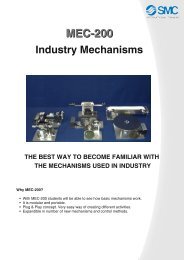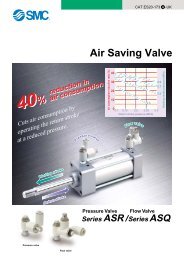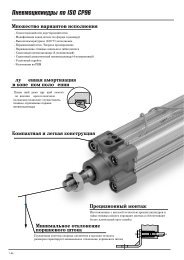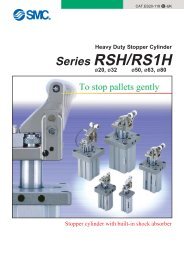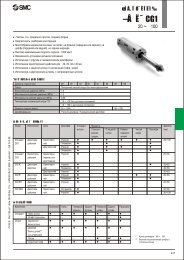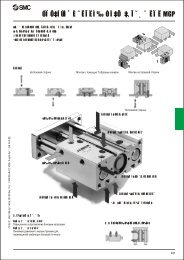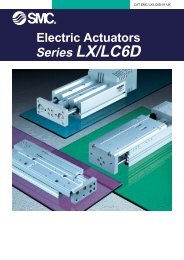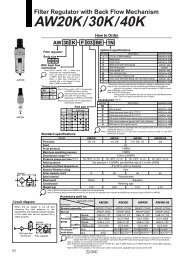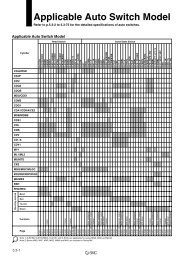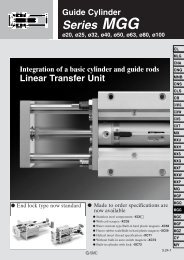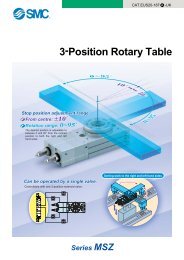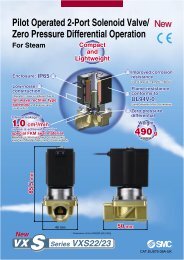Process PumpSafety InstructionsThese safety instructions are intended to prevent a hazardous situation and/orequipment damage. These instructions indicate the level of potential hazard bylabels of "Caution", "Warning" or "Danger". To ensure safety, be sure toobserve ISO 4413 Note 1) , ISO 4414 Note 2) , JIS B 8361 Note 3) , JIS B 8370 Note 4) , JISZ 9102 Note 5) and other safety practices.CautionWarning: Operator error could result in injury or equipment damage.: Operator error could result in serious injury or loss of life.Danger: In extreme conditions, there is a possible result of serious injury or loss of life.Note 1) ISO 4413: Hydraulic fluid power – General rules for the application of equipment to transmission and contorolsystems.Note 2) ISO 4414: Pneumatic fluid power – General rules relating to systems.Note 3) JIS B 8361: General Rules for Hydraulic SystemsNote 4) JIS B 8370: General Rules for Pneumatic EquipmentNote 5) JIS Z 9102: Piping identification markingsWarning1. The compatibility of the equipment is the responsibility of the person whodesigns the system or decides its specifications.Since the products specified here are used in various operating conditions, their compatibility for thespecific system must be based on specifications or post analysis and/or tests to meet the specificrequirements. The expected performance and safety assurance are the responsibility of the personwho has determined the compatibility of the system. This person should continuously review thesuitability of all items specified, referring to the latest catalogue information with a view to giving dueconsideration to any possibility of equipment failure when configuring a system. Be particularly carefulin determining the compatibility with the fluid to be used.2. Only trained personnel should operate machinery and equipment.The fluid can be dangerous if handled incorrectly. Assembly, handling or repair of the systems shouldbe performed by trained and experienced operators.3. Do not service machinery/equipment or attempt to remove components untilthe safety is confirmed.1. Inspection and maintenance of machinery/equipment should only be performed once measures toprevent falling or runaway of the driven objects have been confirmed. Measures to prevent dangerfrom a fluid should also be confirmed.2. When equipment is removed, confirm the safety process as mentioned above. Release the fluidpressure and be certain there is no danger from fluid leakage or fluid remaining in the system.3. Carefully restart the machinery, confirming that safety measures are being implemented.4. Do not use the product if it will use in an of the following conditions:1. Conditions or environments beyond the specifications given in the catalogue and instruction manual.2. With fluids whose application causes concern due to the type of fluid or additives, etc.3. Installation on equipment in conjunction with atomic energy, railway, air navigation, vehicles,medical equipment, food and beverages, recreation equipment, emergency stop circuits, clutch andbrake circuits in press applications, or safety equipment.4. An application which has the possibility of having negative effects on people, property, requiringspecial safety analysis.Back page 2
Process Pump Precautions 1Be sure to read this before handling.Refer to the main catalogue sections for detailed precautions on each series.Caution on DesignWarning1. Check the specifications.Give careful consideration to operating conditions such asthe application, fluid and environment, and use within theoperating ranges specified in this catalogue.2. FluidRegarding the component parts material and the fluid compatibility,check the applicable fluid check list (see back page 1)prior to use. Please consult with <strong>SMC</strong> for fluids other thanthose on the check list. Also, please use within the operatingfluid temperature range.3. Maintenance spaceThe installation should allow sufficient space for maintenanceactivities. Use the product, considering that liquid may leakfrom the product.4. Fluid pressureDo not apply pressure to the operating fluid.5. Ambient environmentOperate within the ambient operating temperature range. Afterconfirming the compatibility of the product’s componentmaterials with the ambient environment, operate so that fluiddoes not adhere to the product’s exterior surfaces.6. Liquid ringsIn cases with a flowing liquid, provide a by-pass valve in thesystem to prevent the liquid from entering the liquid seal circuit.7. Measures against static electricityTake measures against static electricity as static electricitymay occur depending on a fluid.8. Suspension of the pump operationFor the automatic operation type, use a 3-port solenoid valvewhen the process pump is started or stopped by the pilot air.If the pump should stop while consuming the residual pressure,the integral switch part of the pilot air may not be stabilisedor cannot be restarted. If it should not restart, press thereset button.9. Cannot be used for gaseous transfer.When used for gaseous transfer, sufficient transfer volumecannot be gained due to the nature of compression. Besides,as the operational cycle is too fast, unexpected malfuctionsmay occur within short periods of time.10. Use the constant pilot air pressure.The pump may malfunction and stop when the pilot air pressurefluctuation exceeds 50 kPa because the automaticallyoperated type adopts an air spring for the in-built air controlcircuit.11. Use a design which prevents reverse pressure andreverse flow.If reverse pressure or flow occurs, this can cause equipmentdamage or malfunction, etc. Take measures in designing thecircuit diagram.Warning12. Condensation and freezing of the pilot portFor the automatically operated type, the location around theswitching valve and the air exhaust part can cool down quicklydue to expansion of the supply air, this may cause the pipesto freeze. Take measures to ensure that water droplets arenot splashed onto any electric parts or equipment.CautionMounting1. The sealed package should only be opened inside aclean room.This product is double packed inside a clean room. We recommendthat the inner package should be opened inside aclean room or clean environment.2. Confirm the mounting orientation of the product.Mount the product, with its bottom surface facing downwards.Fix all the mounting locations prior to use.CautionPiping1. Flush the pipes.Connect the product after flushing and washing the pipes. Ifany foreign matter is left in the pipes, malfunction or failuremay occur.2. Use the fittings with a resin thread when piping tothe pilot port.Using fittings with metal threads may result in damage to thepilot port.3. Always tighten threads with the proper tighteningtorque.When screwing fittings into valves, tighten with the propertightening torque shown below.Connection threadRc, NPT, G 1/8Rc, NPT, G 1/4Rc, NPT, G 3/8Proper tightening torque (Nm)0.4 to 0.50.8 to 12 to 2.5Back page 3



